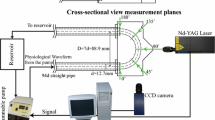Abstract
The effects of unevenly distributed flow were investigated in a symmetrically branched tube with an angle of branching and branch-to-trunk area ratio that were comparable to the human descending aorta. Profiles of velocity were measured at the vertex of the bifurcation with a laser Doppler anemometer during pulsatile flow as well as steady flow. The mean Reynolds numbers were 500, 1000, and 1500. When flow in the branches was equal, reversals were present along the outer wall during the minimal phase of the flow cycle at a Reynolds number of 500. Such reversals were absent at higher Reynolds numbers. When flow in the branches was unequal, reversals occurred only in the branch with the lower flow. Such reversals occurred at all of the Reynolds numbers studied. Pulsatile flow separation, however, did not occur at any Reynolds number when the flow in the branches was equal. Pulsatile flow separation occurred in the partially occluded branch when flow in the branch was ≤8% of the total flow only at Reynolds numbers of 1000 and 1500. A prominent difference between pulsatile and steady flow was that reversals along the outer wall occurred during pulsatile flow at percentages that were prominently higher than the percentage of flow in the branch that produced reversals during steady flow. These observations may be pertinent to understanding the potential of characteristics of flow in the genesis of atherosclerosis in the region of the bifurcation of the aorta.
Similar content being viewed by others
References
Beales, J.S.M. and R.E. Steiner. Radiological assessment of arterial branching coefficients.Cardiovasc. Res. 6: 181–186, 1972.
Brech, R. and B.J. Bellhouse. Flow in branching vessels.Cardiovasc. Res. 7: 593–600, 1973.
Caro, C.G., J.M. Fitz-Gerald, and R.C. Schroter. Atheroma and arterial wall shear: Observation, correlation and proposal of a shear dependent mass transfer mechanism for atherogenesis.Proc. Roy. Soc. Lond. B. 177: 109–159, 1971.
Cheng, L.C., M.E. Clark, J.M. Robertson, and N.H. Chao. Effects of flow division on bifurcation flow characteristics. In:Proceedings First Mid-Atlantic Conference on Bio-Fluid Mechanics, edited by D.J. Schneck. Blacksburg: Virginia Polytechnic Institute and State University, 1978, pp. 151–160.
Despard, R.A., and J.A. Miller. Separation in oscillating laminar boundary layer flows.J. Fluid Mech. 47: 21–31, 1971.
Feuerstein, I.A., O.A. El Masry, and G.F. Round. Arterial bifurcation flows-effects of flow rate and area ratio.Canad. J. Physiol. Pharmacol. 54: 795–808, 1976.
Friedman, M.H., V. O’Brien, and L.W. Ehrlich. Calculations of pulsatile flow through a branch: Implications for the hemodynamics of atherogenesis.Circ. Res. 36: 277–285, 1975.
Lallemand, R.C., K.G.E. Brown, and P.S. Boulter. Vessel dimensions in premature atheromatous disease of aortic bifurcation.Br. Med. J. 2: 255–257, 1972.
Malcolm, A.D. Flow phenomena at bifurcations and branches in relation to human atherogenesis: A study in a family of glass models. M. Sc. Thesis. University of Western Ontario, 1975.
Prandtl, L. Uber Flussigkeitsbewegung bei sehr kleiner Reibung. In:Verhandlung des III Intern. Math. Kongresses. Ann Arbor: Edwards Bros., 1943, pp. 1–3.
Stehbens, W.E. Flow in glass models of arterial bifurcations and berry aneurysms at low Reynolds numbers.Q. J. Exp. Physiol. 60: 181–192, 1975.
Stein, P.D., H.N. Sabbah, D.T. Anbe, and F.J. Walburn. Blood velocity in the abdominal aorta and common iliac artery of man.Biorheology 16: 249–255, 1979.
Schlichting, H.Boundary-Layer Theory (6th Ed.). New York: McGraw-Hill Book Co., 1968, pp. 123, 443, 445, 468–469.
Stein, P.D., H.N. Sabbah, and E.F. Blick: Contribution of erythrocytes to turbulent blood flow.Biorheology 12: 293–299, 1975.
Stein, P.D., H.N. Sabbah, and F.J. Walburn. Characteristics of flow in the human cardiovascular system in normal and disease states. In:1979 Biomech. Symposium, edited by W.C. Van Buskirk. New York: The American Society of Mechanical Engineers, 1979, pp. 169–172.
Stein, P.D., F.J. Walburn, and E.F. Blick. Damping effect of distensible tubes on turbulent flow: Implications in the cardiovascular system.Biorheology 17: 275–281, 1980.
Walburn, F.J., E.F. Blick and P.D. Stein. Effect of the branch-to-trunk area ratio on the transition to turbulent flow: Implications in the cardiovascular system.Biorheology 16: 411–417, 1979.
Walburn, F.J., E.F. Blick, and P.D. Stein. Flow in a symmetrically branched tube simulating the aortic bifurcation: The effect of the mean Reynolds number.Proc. 33rd Annual Conf. Eng. Med. Biol., 1980.
Walburn, F.J. and D.J. Schneck. An experimental technique for quantifying unsteady flow separation in diverging circular channels. In:Proceeding First Mid-Atlantic Conference on Bio-Fluid Mechanics, edited by D.J. Schneck. Blacksburg: Virginia Polytechnic Institute and State University, 1978, pp. 161–170.
Walburn, F.J. and P.D. Stein. Effect of vessel tapering on the transition to turbulent flow: Implications in the cardiovascular system.Fed. Proc. 39: 1068, 1980.
Walburn, F.J. and P.D. Stein. Flow characteristics in symmetrically branched tubes simulating the human aortic bifurcation.J. Biomechanical Engin. (in press).
Zeller, H., N. Talukder, and J. Lorenz. Model studies of pulsating flow in arterial branches and wave propagation in blood vessels. InFluid Dynamics of Blood Circulation and Respiratory Flow. Naples: AGARD, 1970, pp. 15.1–15.8.
Author information
Authors and Affiliations
Additional information
Supported in part by the U.S. Public Health Service-National Heart, Lung and Blood Institute Grant HL23669-02
Rights and permissions
About this article
Cite this article
Walburn, F.J., Stein, P.D. Flow in a symmetrically branched tube simulating the aortic bifurcation: The effects of unevenly distributed flow. Ann Biomed Eng 8, 159–173 (1980). https://doi.org/10.1007/BF02364662
Issue Date:
DOI: https://doi.org/10.1007/BF02364662




